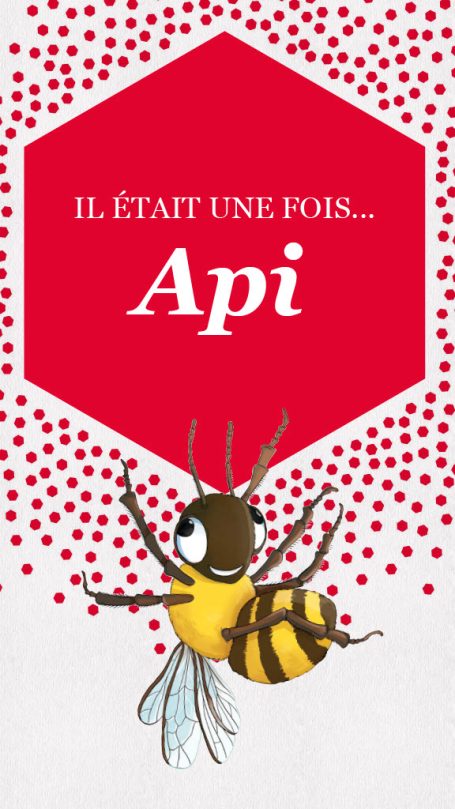La petite histoire d'API

Last year, my mother, foresighted and experienced, built up large reserves of honey and pollen in the autumn, during the strawberry tree bloom, to endure the cold, damp, and windy winter. Before the honey flow ended, she slowed down her egg-laying and even stopped entirely during the Christmas season, conserving her strength for the approaching spring.
The number of my sisters was carefully calculated. In winter, work consists solely of consuming honey to burn calories and maintain the nest at the right temperature. A large population isn’t needed for this, as honey reserves act as excellent insulation. Imagine a cluster of bees, the size of a handball, huddled together, surrounded by 40 kg of honey.
For the past few weeks, days have been growing longer, and temperatures seem to be rising. My mother has noticed and resumed her work, laying as many eggs as the small colony can feed. But in early spring, my sisters must wait for the temperature to exceed 14°C before they can venture out to forage for a few hours each day.
The plants that bloom this season know that bees are scarce, which is why only a few species dare to blossom. Gradually, the warmth returns, my sisters stay outside longer, flowers multiply, and activity intensifies within the colony. Seeing the reserves grow, my mother lays more and more eggs each day. My sisters hatch one after another, contributing to feeding the larvae.
The Return of Warm Days and Mating Season
With the warm days, the mating season approaches. Preparation must begin in advance. During winter, the colony refused to feed the males, deeming them useless and too greedy. In Corsica, there is a short period when no drone survives—they all perish from starvation.
But today, my mother has resumed laying male eggs in larger cells. My sisters carefully nourish them, stuffing them to make them robust. They will hatch in 25 days, needing a few more weeks to reach full maturity.
Unlike my sisters, the males have no specific role in the hive. They neither work nor feed themselves. They spend their time flying from hive to hive, begging for food. They leave the hive around 10 a.m., long after my sisters, and spend the day loitering at the entrance. Larger than the worker bees, they have enormous eyes, probably to better spot young queens. But their heads, burdened by these globes, have little room left for a brain.
They have a strong odor… somewhat like a billy goat.
The Colony’s Expansion
Weeks pass, flowers become more abundant, and the hive thrives. My mother lays eggs at an incredible rate—5,000 per day. To feed this growing population, my sisters forage tirelessly, collecting nectar and pollen. As they dive into flowers, they become covered in pollen grains, which they gather into small pellets attached to their hind legs.
Some of my sisters have a special mission: collecting water. They prefer stagnant puddles or dewdrops left on the grass. Water is used to prepare food for the larvae and regulate the hive’s temperature. When it’s hot, my ventilating sisters create an airflow that, through evaporation, cools the entire colony.
Swarming
When the colony becomes too large, my mother prepares to leave. My sisters have built royal cells, and my mother has laid eggs in them. Among these larvae, one will become queen: ME.
Fed exclusively on royal jelly, I develop functional reproductive organs, unlike my worker sisters. A week after my birth, my mother leaves the hive, taking half the colony with her. They fly off in a buzzing whirlwind in search of a new home.
My Reign Begins
Inside the hive, my rivals and I know that there can only be one queen. We eye each other warily, aware that only the strongest will survive. A week after my birth, the moment arrives. I leave the hive, soaring into the bright sky. The drones, gathered in a waiting swarm, spot me immediately and give chase. Mating takes place in mid-air, and then I return triumphantly to the hive.
Two days later, invested in my role, I lay my first egg. I am now the mother of this colony. My people watch over me while I dedicate myself to my mission: laying, laying, always laying.
Thus goes the life of bees, in rhythm with the seasons, from birth to swarming, ensuring that the endless dance of our people never ceases.
©Le Jardin des Abeilles. Tous droits réservés. Mentions légales.
Nous avons besoin de votre consentement pour charger les traductions
Nous utilisons un service tiers pour traduire le contenu du site web qui peut collecter des données sur votre activité. Veuillez consulter les détails dans la politique de confidentialité et accepter le service pour voir les traductions.











